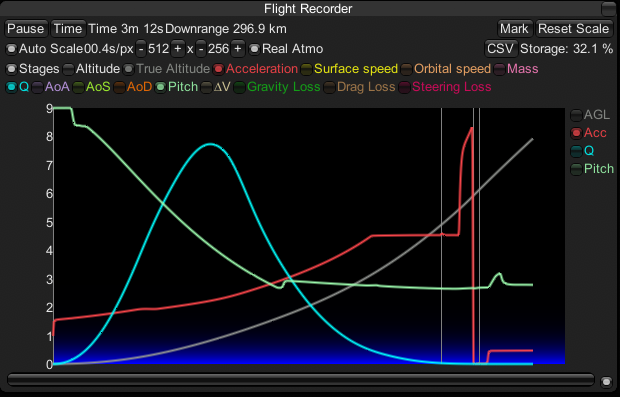Thanks for the super detailed report. So if I understand correctly: v1.2 correctly held constant acceleration, even if a jettison event occurred during the const-acc phase, but v1.3 suddenly throttles up at this event? And you're sure it's a throttle up, i.e. it's not possible that the mass drops so low that your engine even at the lowest throttle setting cannot hold the requested acceleration? (From the look of those awesome plots I suppose not, but just making sure.) If so, this certainly shouldn't happen. Sounds like an issue with the virtual stage generation, and if so, should be fairly easy to track. I'll look at this as soon as I can.
Also thanks for pointing out the issue with engine spool up. I've noticed this in my own designs, I'm pondering on how to do this. I'll open a separate issue for this and ping you there if I have any ideas.
Also thanks for the proof of concept for solving #45. I'll test it and push a fix.
Oh boy, v1.3.1 here we go ;D



Hey, updating from v1.2 to v1.3 for most of my rockets the g limiter disengages between fairing separation and burnout of the first stage. This happens to all rockets where the fairings separate after PEGAS throttles the engines for constant acceleration. Nothing in the boot scripts changed, although I have changed the PEGAS code in a few ways: In 1.2:
In 1.3
This is the same launch vehicle with the same script, just going from 1.2 to 1.3 including everything mentioned above. The scaling is different, but the sudden throttling is easily noticable:

And here the boot script as it originally was:
With this rocket I could mitigate the problem by moving fairing separation within seconds of burnout without losing an appreciable amount of payload, as there is a around five second delay from jettison to 100% throttle. But with some vehicles it's immediate and I'd need to carry the fairings to way outside the atmosphere.
Apart from that, the ascent trajectory is so much smoother in 1.3, so really good work on that! I (mostly) really enjoy using PEGAS. ;)